一座有煙的山
幾扇窗
謝騆瑜個展
a mountain with smoky air and the scenery
Jhouyu HSIEH Solo Exhibition
5/5-6/12
妖魚獺誌這個系列是藝術家騆瑜藝術計畫《滅絕物種的生活模式》的第三部曲;由行為表演、錄像聲音裝置、印刷文本、數碼繪畫以及物件裝置所組成,我試圖以多層次的手法呈現因人類而滅絕的物種暨當代生活之間的特殊性,並從這些畫面裡再次想像人類與已滅絕物種間彼此相依的共生關係,以及建設與環境生態對立之間的另一種可能。
This art work series “The Classic of Tilapia-eating monster” belongs to the third part of artist Jhouyu HSIEH’s art project “Patterns of Extinct Life”, which contains performance, video, sound, print, digital painting and installation. I tried to present the uniqueness between species which were extinct by humans and contemporary life in multi-layered way, imagining the symbiotic relationship in humans and extinct species again from these art work and another possibility between construction and environmental ecology.
2050之後,是否將有四分之一的物種在地球上消失滅絕......
-聯合國(IPBES)《全球生物多樣性與生態系服務評估報告(the Global Assessment of Biodiversity and Ecosystem Services)》
After 2050, will a quarter of the species disappear from the earth...
-The United Nations (IPBES) "The Global Assessment of Biodiversity and Ecosystem Services"
歐亞水獺(Lutra lutra),是一種擁有短頸、闊面、長尾的夜行性動物,分布於歐亞非三大洲,在現存7屬13種水獺中分布最廣,但20世紀下半葉開始,因為全球性的快速工業化、人類大量使用對環境危害的多氯聯苯及有機氯殺蟲劑、路殺、捕獵毛皮和棲息地的消失等因素,水獺數量急遽下降;21世紀初期,隨著大部份有害殺蟲劑的禁用及人為的保護,水獺數量瀕危趨勢減緩,國際自然與自然資源保護聯盟(IUCN)將歐亞水獺列為近危物種。
The Eurasian otter (Lutra lutra) is a kind of nocturnal animals with short neck, broad face and long tail. It is distributed on three continents of Europe, Asia and Africa. It is the most widely distributed among the existing otters of 7 genera and 13 species. However, since the second half of the 20th century, the rapid global industrialization, the extensive use of polychlorinated biphenyls and organochlorine pesticides that are harmful to the environment by humans, road killings, fur hunting, and the disappearance of habitats have caused a sharp decline in the number of otters. In the early 21st century, with the prohibition of harmful pesticides and artificial protection, the endangered trend of the number of otters has slowed down, and the International Union for the Conservation of Nature and Natural Resources (IUCN) has listed the Eurasian otter as a near threatened species.

在台灣地區的歐亞水獺僅存分布於離島金門,台灣本島的野生水獺已滅絕;除此之外,日本、列支敦士登、荷蘭及瑞士的野生歐亞水獺也已消失滅絕。
在過去的金門,地處戰爭之前哨要地;1949年,軍隊進駐,為了配合戰地任務而限制了民間的槍枝獵捕、山林土地開發與當地百姓的日常活動。金門因數十年來的軍備需求而進行的戰地策略卻意外提供島上生態天然的庇護狀態,也因此讓金門相對於台灣本島地區,人煙較為稀少、環境未受到破壞。而因戰備及民生用水需求,軍隊在離台灣本島極為偏遠的金門島嶼挖掘了上百座儲水庫池嶼湖泊,這些水域與海岸相交織連通,也創造了更適合歐亞水獺生存與擴散的棲地環境。
The only remaining Eurasian otters in Taiwan area are in the outlying island named Kinmen. The wild otters on Taiwan’s main island have become extinct. In addition, the wild Eurasian otters in Japan, Liechtenstein, Netherlands and Switzerland have also disappeared.
In the past, Kinmen was an important outpost in the war. In 1949, the army stationed in Kinmen, in order to cooperate with the battlefield mission, the civilian gun hunting, the development of mountain forest land and the daily activities of the local people were restricted. The battlefield strategy carried out by Kinmen due to decades of armament needs has unexpectedly provided the island with a natural sanctuary. As a result, Kinmen is relatively sparsely populated and has no environmental damage compared to the main island of Taiwan area. Due to combat readiness and water demand for people’s livelihoods, the army excavated hundreds of reservoir ponds and lakes in Kinmen, which is extremely remote from the main island of Taiwan. These waters are intertwined with the coast and created a habitat that is more suitable for the survival and proliferation of Eurasian otters.
The Eurasian otter is a very territorial species, also has the habit of using excretion to indicate the area. According to the analysis of the Eurasian otter in the Kinmen and the DNA sequencing study, the Wu Guo fish is the most commonly supplemented food of the otters in Kinmen (Wu Kuo fish are mainly Geely cichlids and Nile hatched fish). Since 1946, Taiwan has introduced a variety species of Wu Kuo fishes. Under the improvement of aquatic technology, new ones have been cultivated. Wu Guo fish is a wide-salt species which can survive in sea or fresh water. It has also become an important economic fish species in Taiwan's aquaculture fishery. Wu Guo fish has become an important source of food for Kinmen otters due to its easy survival and strong reproductive ability. DNA of Wu Guo fish has been found in more than 70% of Kinmen otter samples. Wu Guo fish is an exotic species with a devastating threat to many native fish species, which may cause the extinction of Kinmen native betta and other fish species, but it has become the main food source supporting the endangered Kinmen otter.
歐亞水獺是一種領域型極強的物種,也有利用排遺來標示領域的習性,而根據對金門地區歐亞水獺的排遺內容物分析法及DNA定序研究,吳郭魚是金門水獺食性裡最常被補食的物種(吳郭魚主要是吉利慈鯛及尼羅口孵魚兩種),台灣自1946年之後,引進多種吳郭魚類,在水產技術改良之下,培育出新的養殖品種;吳郭魚屬廣鹽性,在海域或淡水皆能存活,也成為台灣養殖漁業重要的經濟魚種。養殖食用引入吳郭魚在逃逸至金門各水域後,因其易於生存與繁殖力強的特性大量繁衍,也成為金門水獺重要的食物來源,在七成以上金門水獺的排遺樣本裡都發現了吳郭魚的DNA;吳郭魚對許多原生魚種而言是具有毀滅性威脅的外來種,可能造成金門原生蓋斑鬥魚等魚種的滅絕,卻反而成為支撐瀕危金門水獺的主要食物來源。
在這件作品裡,我採用金門水獺的檔案調研資料,以重新編碼的方式,將金門水獺所代表的區域性生態滅絕現象描繪於帶有敘事性的畫面之中,在我的故事裡,金門水獺與吳郭魚從衝突到攜手融合,進而形塑一種在未來世界全身心靈都被吞噬的神異物種。
藝術家以自身家鄉本島與離島、滅絕與存留的歐亞水獺出發,作為一種連結歐亞非三大洲的生態量表,越過身為台灣人生命感受的歷史現狀與結構,也似乎訴說著一種全球共通的物種生命狀態,在原生種滅絕與外來種肆虐間交織與掙扎。
In this work, I used the archives and research data of Kinmen otter to recode the regional ecological extinction in a narrative picture. In my story Here, the otter and Wu Guo fish go from conflict to fusion, and then form a kind of mysterious species that will be swallowed up in the future world.
The artist starts from her home islands and outlying islands, the extinct and remaining Eurasian otters, as an ecological scale that connects the three continents of Europe, Asia and Africa. It transcends the historical status and structure of life as a Taiwanese, and it seems to tell a global common state of species life. The state of life is intertwined and struggling between the extinction of native species.




